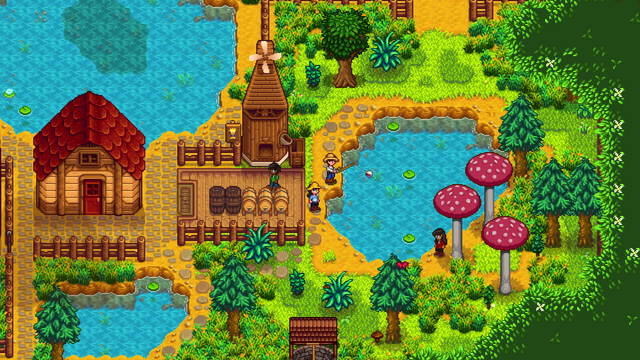Remember Slender? (Slender: The Arrival, specifically?) Its small development team — Blue Isle Studios — has grown, and the new project they’re working on is bigger, too. They’ve gone from three to nine developers, and their next game, Valley, is a completely different kind of a thing — a kind of nature-parkour game with shooting and life-stealing mechanics, actually.
Valley sticks the player in a kind of rusty WW2 super-suit with very powerful jumping-legs. Running downhill builds up momentum and speed, allowing the player to leap extremely high and far; most of the challenges in the game seem to involve exploiting platforms and slopes in the environment to reach distant areas too remote for the suit’s standstill jump.
The suit’s other major ability involves sucking a kind of life-force out of the plants and animals in the game. Some dead trees in the environment function like switches; shooting life-force energy into them can open doors. Some enemies will ‘become pacified’ (read: die) when, FPS-style, you shoot enough life-energy into them.

I got my hands on Valley earlier this week and was able to take the jump-legs for a spin and, yes, it’s a cool central mechanic, particularly when the levels are open, sandboxy places full of lots of natural slopes and hillocks. It’s not a freerunning game or a parkour game, but its focus on momentum and feats of first-person environment traversal remind me a little but of others I have played. I haven’t seen a first person running/parkour game that focuses so much on momentum and natural, “soft” environments, rather than on clambering all over some kind of human construction. The part I played focused mostly on the basics of this traversal mechanic: there were lots of bike-ramp-like upward slopes in the environment, and I spent most of my time trying to identify the downward slope that would allow me to get the most distance or height out of these launchpads. Launching yourself just right is definitely a thrill.
Not all of the game involves bouncing off hilltops on the open plains, though. There are underground platforming sections in several (decidedly-more-cramped) caves, and a few levels contain crevasses that require a kind of hookshot upgrade to cross.
I did not personally get a chance to test any of the combat myself, but the developers did demonstrate a late-game fight to me. Combat involves both shooting life energy at enemies and tactically deciding when to suck it out of the environment and refill your “ammunition” and health.
When you take too much damage from enemies (or jump into a lake), you’ll die, and your suit will revive you with life-force sucked out of the environment. So, for example: I saw the player fall down a ravine and come back to life on a path where the nearby animals and trees had died in their place. The environment has its own “health bar,” reflected both in your UI and in the lighting, skybox, grass colors, and alive/dead state of the level around you. You can improve this kind of meta-health-bar by collecting life-force and shooting it back into any withered trees and animal corpses you find.

While figuring out the jumping mechanics, I fell into a lot of lakes, and every time I died I had to stand on a hilltop and shoot every dead tree I could see to raise the HP of the environment. I’m not convinced this part of the game is really as dramatic and special as the Life! Death! theme tries to make it seem, but I only saw a tiny sliver of the game, and I’m interested in seeing how this mechanic works in the parts of the game that aren’t as open or sandboxy. In the part I played, raising the environment’s HP was trivial, because you could always find enough trees to shoot if you puttered around for long enough. Blue Isle told me that this wouldn’t be the case in other parts of the game, where decisions about when and how to revive dead things or suck life out of the level were sometimes more limited and tactical. It seems like this mechanic could make for some pretty interesting platforming challenges.
The Blue Isle developer I spoke to told me that every time they test a full playthrough with a new tester, they see that player find new and surprising ways to break out of the game’s critical path and reach places at times or in ways the developers didn’t know were possible. As a result, they’ve focused on sprinkling the environment with stuff to find in strange and out-of-the-way places to reward this behavior, rather than punish it. Doing a strict runthrough of just-the-basics in The Valley will take only three to four hours, but the player will miss out on chunks of the story and on numerous suit upgrades and hidden secrets. (They’re very excited, actually, to see how speedrunners treat this game.) They estimate that a full playthrough by someone dedicated to exploring and testing the suit’s abilities could take as long as ten hours.
As for the story: those ten hours are set in a mysterious valley (obviously!) in the American Rocky Mountains. The plot is told almost entirely through audio-logs recorded by a WW2-era scientist who was investigating the valley the player spends most of the game leaping around. The bits I saw seemed like a combination of Indiana Jonesesque ruins exploration and a WW2-era science-fantasy mad scientist story. There are a lot of ruined bases and blue-glowin’ old technology and weird, flickering, sprite-like creatures scuttling around in the grass. I’m going to admit, the bits of the story I saw were not the best-written story-fragments of all time, but it seems like earnest, save-the-world!-scale stuff, and some of the parts of the story I saw seem pretty unique.
In general, most of what I saw seems like a big step up over Slender, even though the two games are very hard to compare. The art’s an improvement, the traversal mechanics are interesting, and the scale of the game– both its sheer environment size and its goals as a game– seems a lot bigger. I’m interested in seeing what comes of it!
Valley is releasing this summer on PC, PS4, and XBox One.




